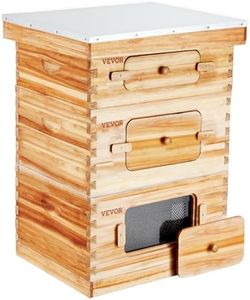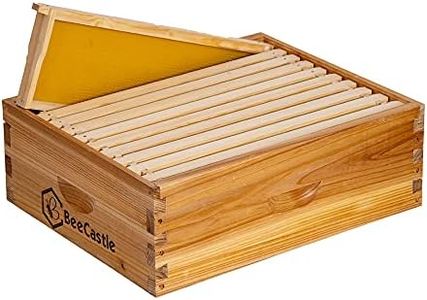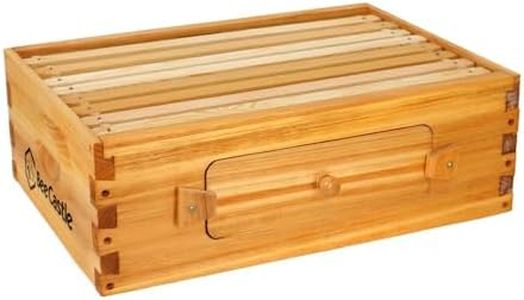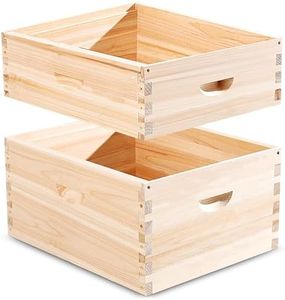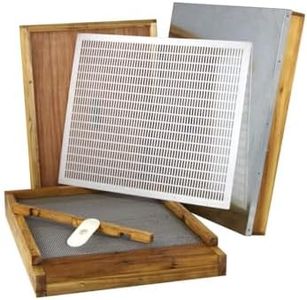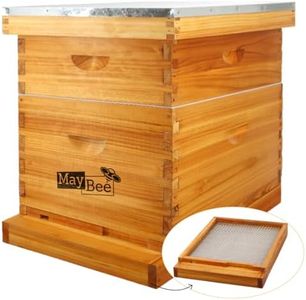We Use CookiesWe use cookies to enhance the security, performance,
functionality and for analytical and promotional activities. By continuing to browse this site you
are agreeing to our privacy policy
10 Best Bee Hives
From leading brands and best sellers available on the web.Buying Guide for the Best Bee Hives
Choosing the right bee hive is crucial for beekeepers, whether you're just starting out or have some experience. The hive you pick impacts the health of your bees, how much honey you can harvest, and how easy it is to manage the colony. You'll want to consider factors related to your climate, your ability to lift and handle hive components, and how involved you want to be with bee management. Getting familiar with the main features and specifications will help you make a choice that matches your needs and keeps your bees thriving.Hive TypeHive type refers to the overall design and structure of the bee hive, and it's important because it shapes the way you manage the bees and harvest honey. The common types are Langstroth, Top Bar, and Warre hives. Langstroth hives are boxy and stackable, great for expanding colonies and easier honey harvesting. Top Bar hives are long horizontal boxes, making inspection easier and lifting less demanding, often preferred for small-scale or backyard beekeepers. Warre hives are more vertical and mimic natural tree hollows, requiring less frequent intervention but potentially harder for honey extraction. Your choice depends on whether you value easy honey collection, minimal interference, or simple handling—so think about how hands-on you want to be and how physically challenging hive management might be for you.
MaterialMaterial means what the hive is made from, and it's important for the bees' health and the hive's durability. Most hives are made from wood (such as pine or cedar), but there are also plastic options. Wood is natural and insulates well, helping bees regulate temperature, but it may need treatment and is heavier. Cedar is lighter and more resistant to rain and pests, while pine is typically more affordable. Plastic hives are lighter and more weather-resistant but may not breathe as well and can get hot in the sun. If you want low maintenance and durability, plastic could work, but for a more natural environment and better temperature management, wood is usually the better pick.
Frame Size and NumberFrame size and number indicate how many removable frames fit in each box and their dimensions, which impacts colony size and honey yield. Larger frames mean bees have more space for brood and honey, and more frames per box mean fewer boxes, but boxes will be heavier when full. Smaller frames can make for lighter boxes, easier for those who can't lift much weight. If you want to harvest more honey and don't mind heavy lifting, larger frames and more per box are great. If mobility, ease of inspection, or lighter lifting is necessary for you, smaller frames or fewer per box may be better.
VentilationVentilation refers to how air flows through the hive, helping bees keep cool in summer and reducing moisture that can harm the colony. Some hives include vents, screened bottoms, or special covers to increase air flow. Good ventilation is critical in hot or humid climates to prevent your bees from overheating or being plagued by mold. If you live somewhere hot or wet, prioritize hives with more built-in ventilation features, but if you're in a cooler area, make sure too much heat doesn't escape.
Ease of InspectionEase of inspection is how simple it is to open the hive and check on your bees without disturbing them. Some hives have lift-off lids, easily removable frames, and clear access, while others can be cumbersome or require more work to open up. For beginners or those wanting regular monitoring, choosing a hive with straightforward inspection features is helpful, as it makes managing bee health and honey collection much more manageable.
ExpandabilityExpandability is about whether you can add more boxes or sections to the hive as your colony grows. Some hives are easy to stack with additional boxes, giving the bees more room as they multiply, while others are more limited in how they can be expanded. If you expect your bee colony to grow quickly or want to harvest more honey later, look for a hive that's designed for easy expansion, but if you're starting small or keeping just one or two colonies, simplicity might be fine.


